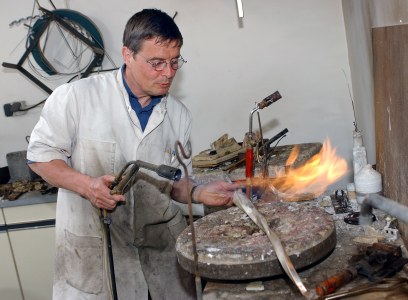THE INDEPENDENT - Saturday 20 February 1999
Dutch silversmith Jan van Nouhuys is devoted to reinventing a near-forgotten art.
By Karen Falconer
When Jan van Nouhuys turned his back on jewellery design as a young man to work purely in silver, he had no intention of making knives and forks or even rings, but had bigger things in mind. Seduced by the precious metal’s reflective and sculptural qualities, this Dutchman hoped to breathe modernity into a dwindling skill. Thirty years on, his work graces the collections of world leaders and will show as a centrepiece of next week’s Spring Olympia Fine Art and Antiques Fair, where his pieces are seen as possible antiques of the future.
According to David Beasley, librarian at the Goldsmiths' Hall which promotes contemporary silver and jewellery, van Nouhuys's work blurs the line between the contemporary and classical. "He is acceptable by both ends as he follows traditional silversmithing ideas of function and object, but his work has a pleasing, soft quality and is less angular than some of our British cutting-edge modernists."
In a field with a history of the ornate, Jan van Nouhuys’s silverware is modern and geometrically based. Among his collection are two chatting jugs, about 20cm high, a 14cm cubic teapot, a curious pair of 30cm high twin vases and a basket. Perhaps his best-known work is the table bell-cum-candlestick that he designed for the Dutch government in 1991 as presents for world leaders at the Maastricht summit.”
Silversmithing is an art for van Nouhuys. “I am an artist and silversmith,” he proclaims. “I create as an artist because I do what my heart tells me. It’s about fascination.”
Van Nouhuys has spent his entire adult life (he is now 50 years old) pursuing what he describes as his “inner calling” : helping others to set up in a skill for which no one produces the tools - you have to make them yourself or wait for an existing silversmith to retire; bringing other artists or designers together to produce pieces in silver; organising exhibitions, lecturing, studying past skills and setting up “Silver in Motion”, a project that led to the formation of a centre for contemporary silver in a restored water tower in Schoonhoven, (now a national monument). Later this year, the Association of British Designer Silversmiths will join him there for a collaborative exhibition.
After such lifelong dedication it is perhaps little wonder that he refers to silver as a living muse: “Though obstinate, silver is very kind, gentle, willing, time-consuming, attention-demanding. I want each piece to have a soul. From a straight cubic shape, I want it to start living. I ask ‘How can I bring live to a cubic form?’”
Like the world of nature he so often compares it to, working silver is a long and organic process which affords the silversmith time to consider the way in which the metal plays with light and reflection. Machine-made silver, van Nouhuys insists, is “completely dead” and will never have the artistic value of hand-made pieces (his are normally one-offs).
Sometimes, as with his 30cm sculptured candle stands, wine jugs and a rather ornate bowl with zig-zag edge, he works from a single piece of silver sheeting so the finished product is seamless. It’s almost a point of principle. “Historians used to say it is impossible to work as the famous 17th-century silversmith Adam van Vianen did, creating out of a single silver sheet. As a silversmith, I said it must be possible. I’m not saying I’m as good as him, but I’ve worked out the hypothesis and I’m on the way.” He also works back to front from traditional techniques to make pieces like his cut-silver basket, sawing the diamond shapes out of the sheet before raising it into the shape he wants, or “is allowed to make by the material”. “In this way,” he says, “the holes are all differently subtle and natural.”
Although his pieces sell for thousands of pounds, he insists they are made to be used, not just collected. “Using them is the fourth dimension of each piece,” he stresses. “To take it in your hand and use it . . . Pieces are polished by me in a way that’s almost too nice. It improves when the polish is fading and it’s a bit scratched from being used.”
But how do you evaluate what you are buying in the contemporary silver market? Stephen Burroughs, director of education at the Crafts Council comments: “The value is largely in the design - the shape, form and function - as well as the construction. At its best, silver is thought to be extremely beautiful as well as utilitarian. After that it all comes down to one’s own taste.”













